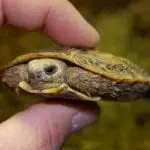Scientific Facts
| Common Name | Green Tree Python |
| Scientific Name | Morelia Viridis |
| Captive Lifespan | 12 to 20 years |
| Size | 1.5 – 1.8 meters (59 – 70.8 inches) |
| Mass | 1.3 – 1.6 kilograms (2.86 – 3.52 pounds) |
| Habitat | Rainforest trees, bushes, and shrubs |
| Country of origin | Cape York Peninsula in Australia, Islands in Indonesia, Papua New Guinea |
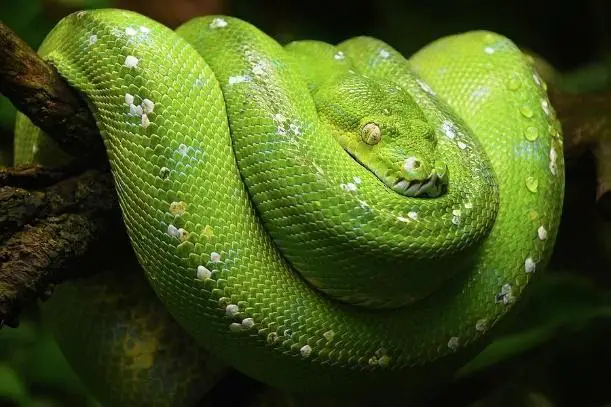
Physical Description
Adult green tree pythons are emerald green in color. The belly of an adult green tree python is yellowish. Also known as tree-dwelling python, some specimens can occasionally display small white marks located along the back.
The coloration of hatchlings is quite different than that of adults, as hatchlings are to change coloration when they reach maturity within about 1 -2 years.
Green tree pythons are known as stout-bodied snakes, and they are relatively short, typically not exceeding 1.8 meters (70. 8 inches) in length.
Similarly to all other pythons, green tree pythons are not venomous. However, they are “equipped” with a set of long, curved teeth. The impressive teeth help a green tree python maintain its grip while struggling prey amongst the dense rainforest’ branches in its natural habitat.
Types
- One of the major characteristics of a green tree python is a slim, triangular body, and a visible spine, with a relatively long tail accounting for approximately 14% of the reptile’s total length.
- The green tree python’s head is clearly defined from the neck, and quite large.
- Large female green tree pythons may reach 200 cm (6.6 ft) length, the size being dependent on the region of origin.
- Male green tree pythons typically weigh about 2.4 – 3.1 Ib. (1100 – 1400 grams). Females typically weigh up to 3.5 Ib. (1600 grams).
- As with most snakes, female green tree pythons are slightly heavier and larger than male green tree pythons, with especially large specimens possibly reaching 4.6 Ib. (2200 grams) of weight.
- Wild green tree pythons are typically much lighter in weight than those kept in captivity.
- It is not accurate to refer to local green tree python varieties as “morphs,” even though they are frequently called morphs colloquially, despite the fact that the so-called “morphs” are not a result of selective breeding, but they occur all naturally.
- “Designer” green tree pythons do exist, as breeders have been attempting to create new, exciting color morphs that do not usually exist in the wild. However, designer green tree pythons are still rather rare.
- Baby green tree pythons can vary in color, ranging from brick red, yellow, or orange, with distinct yellowish/whitish spots outlined in brown and located along their backs.
1) Biak
This type of green tree python morph is described by a green body, with the shades of green greatly varying. The body is marked by asymmetrical yellow patches.
2) Aru
This type of green tree python morph is characterized by a vibrantly green colored body, displaying blue blotches. Randomly, white scales may also appear in clusters, and some species are known to have a blue line bordering their bellies.
3) Jayapura
This type of green tree python morph is described by green-blue body coloration, some white or yellow scales, and distinct blue striping on the back. The tail is black-tipped.
4) Manokwari
This type of green tree python morph is characterized by bright blue dorsal markings that can vary in size and a light-green body. The tail is blue and black.
5) Wamena
Wamena green tree pythons have a deep green body coloration, with dorsal markings colored in darker green or yellow. Patches of black pigmentation can noticeable, too. Sometimes, the markings can be surrounded in blue, and sometimes.
6) Sorong
Sorong green tree python morphs are characterized by a light to medium green body coloration, black-tipped tails, and blue dorsal line, with blue triangles on each side of the line.
Habitat & Lifespan
The green tree pythons’ native habitat encompasses the rainforests of eastern Cape York Peninsula to north Queensland in Australia. Green tree pythons are widely distributed in Indonesia, as well as in Irian Jaya and New Guinea, as well as in Indonesia.
A green tree python’s main habitat is either in or near rainforests. These serpents are known to be primarily arboreal and can be only seen on the ground occasionally. Most of the time, a green tree python is to reside in shrubs, bushes, and trees.
Most captive green tree pythons are found to live well into their mid-teen years, provided the reptile has been taken good care of. However, it is not impossible for a green tree python to make it into its mid-20s, especially in the case proper snake supplies, alongside prioritized, as well as advanced reptile wellness and health practices, are applied by the keepers.
Behavior
Green tree pythons are primarily arboreal creatures. Because of this, it comes as no surprise that these serpents have their very particular way of resting in trees’ branches.
After masterfully looping a coil or two over the branches of shrubs or trees, green tree pythons take a distinct, saddle position, usually placing their heads right in the middle. This fascinating habitual trait is also shared with the South America-native Corallus caninus (emerald tree boa) and keeps causing a lot of confusion among people who are to notice the two serpent species.
When active, green tree pythons usually spend their time crawling through tree branches horizontally, and not up and down the branches. However, even though only occasionally, they also move from one level to another.
1) Caging
- For properly housing a green tree python pet as to admire its beauty to the fullest, keepers should best choose cages that make viewing easy.
- Front-opening glass or plastic reptile terrariums can make a fantastic choice for caging a green tree python. However, as these can be outfitted to accommodating the needs of green tree pythons kept as pets, caregivers may want to cover a particular portion of the terrarium’s screen top for the purpose of maintaining humidity levels within the recommended range.
- Juvenile green tree pythons tend to be shy. Because of this, it is best for juveniles to be started off in smaller enclosures than adults. A 1 foot long, 1 foot tall, 1-foot wide enclosure can work great for starting off a juvenile green tree python.
- Adult green tree pythons require a larger enclosure than juveniles. A 2 foot long, 2 foot wide, the 2-foot tall enclosure can work perfectly, and so can a 3 foot long, 2 foot wide, 2-foot tall enclosure.
- Mind that one of the biggest misconceptions about caging green tree pythons is that the enclosure is supposed to be very tall. However, if a cage is to be quite tall in size, green tree pythons will usually select the highest perch, and since the water bowl is to be typically placed on the floor of the cage, it is often the case that a green tree python will never get down to drunk. As a result, the reptile pet may suffer from dehydration, which can not only affect its general well-being adversely but also its lifespan.
- When caging a green tree python, keepers must remember that with these snakes, horizontal space is much more valuable than vertical space. That’s because green tree pythons are to typically crawl through the trees horizontally.
- When picking a well-fit enclosure to house a green tree python, a general rule is to make sure that the reptile can reach the bottom of the enclosure comfortably from the highest perch.
- As a green tree python is to spend most of its days neatly coiled on a perch, it is a must for keepers to provide an enclosure with sturdy perches or resting branches.
- Keepers should best use multiple climbing branches that range in sizes when caging a green tree python pet. By doing so, the reptile can be provided the much-needed variety of resting spots, and nonetheless, a far more enriched environment.
- When establishing a suitable enclosure for a green tree python snake, caregivers are highly recommended to add a few live plants. Live plants do not only enhance the aesthetics’ of the reptile’s enclosure but are also extremely useful in creating and maintaining a humid microclimate.
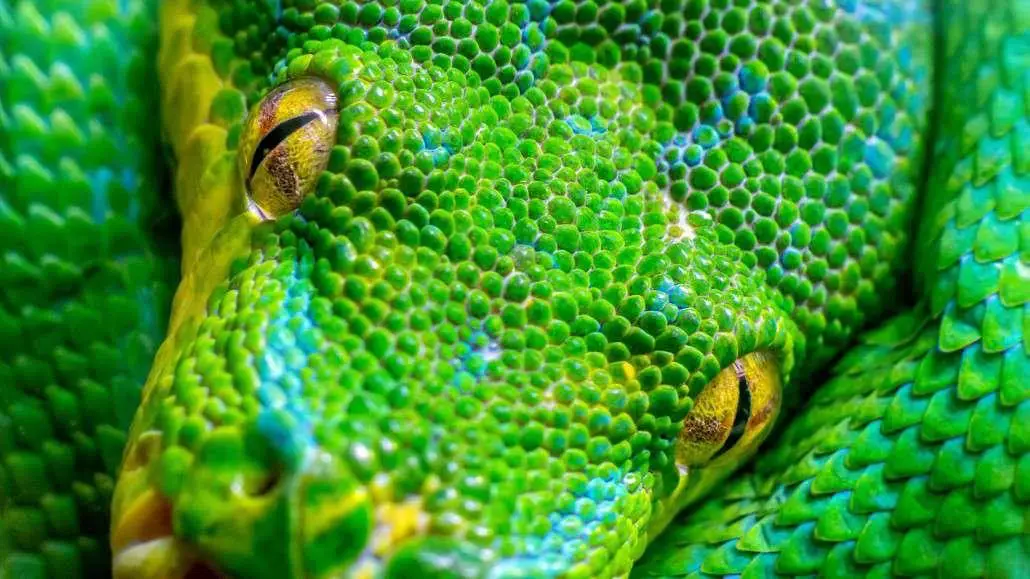
Substrate
There are many suitable substrates for green tree pythons’ enclosures.
1) Newspaper
A newspaper can make an appropriate substrate for green tree pythons and is also a fairly affordable choice. However, a newspaper substrate requires more frequent cleaning services than other substrates and is not the most aesthetically pleasing option.
2) Coconut husk/ Mulch
Various types of mulch can be utilized as a suitable substrate for captive green tree pythons, and the same goes for coconut husk products.
Mulches, as well as coconut husk, offer superior humidity control and maintenance, as compared with using newspaper as a substrate. Not the least, coconut husk products and mulches alike are much more pleasing to the viewer’s eye when admiring the whimsical green tree python.
Dampened coconut husk/ mulch can typically hold moisture for several days. Certainly, that doesn’t mean owners should underestimate the importance of keeping mulch/ coconut husk substrates spot-clean as necessary in order to prevent mold and/or bacteria from causing health issues to the reptile.
Temperature, Lighting & Humidity
- Unlike other reptiles, green tree pythons do not require full-spectrum lighting supplementation in order to help them properly metabolize calcium. However, using a high-quality full-spectrum lamp will help keepers to bring out all the rich, unique, vibrant colors to the fullest.
- In their natural habitat, the day length is constant almost all year-round. Because of this, keepers should best provide their pet green tree python with 12 hours of light daily, using suitable timers to automate the process or by manually switching the lights ON and OFF as needed.
- Since the native habitat of green tree python snakes are tropical rain forests, it is best for captive green tree pythons to be provided with a similarly humid and warm environment. In their natural range, these serpents are too rarely experienced temperatures that fall below 70 degrees Fahrenheit.
- Offering a range of temperatures within the enclosure is extremely important to ensure the well-being of a green tree python pet. By creating a range of temperatures, keepers are to allow the reptile to select its ideal temperature throughout the day and night as needed.
- Caregivers can take advantage of commercial reptile thermometers for the purpose of easily monitoring and/or adjusting the temps within the habitat.
- During the day, a green tree python should be provided to provide an area where it can bask in temperatures set between 86 – 88 degrees Fahrenheit. Also, a retreat where the temperatures are kept within 78 to 80 degrees Fahrenheit should be provided, as well.
- Mind that green tree python snakes must be provided only a place with well-controlled temperatures to retreat, and not a hiding place. The retreat area should be a zone where lower ambient temperatures are maintained. If green tree pythons are granted a lot of hiding areas, they often tend to remain hidden, failing to thermo-regulate properly, and becoming ill in return.
- At night, the temperatures in a green tree python’s enclosure may drop with a few degrees, as compared with daytime temperatures. However, night time temperatures should not get lower than 70 – 72 degrees Fahrenheit.
- The ideal humidity range for green tree pythons falls between 40% – 70%.
- It is okay for keepers to slightly raise the humidity levels in the green tree python’s enclosure, especially after misting. However, humidity rates above 70% should only occur for short periods of time, as keeping the environment wet for too long can cause serious dermal infections to develop.
- Automated misters can greatly help in sustaining the proper humidity levels, as these devices detect when the air gets too dry, letting a controlled spray of water. Alternatively, keepers can also spray the enclosure manually when needed every once in a while, using a small, clean spray bottle.
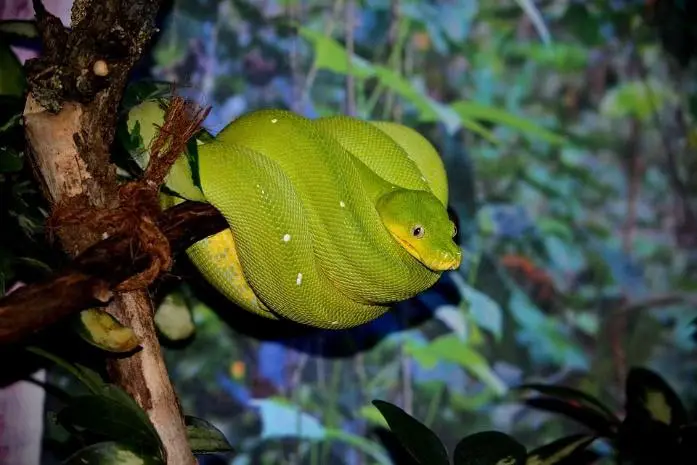
Diet
- Captive green tree pythons thrive on a diet consisting of rodents that are appropriately sized per serving.
- Juveniles should be fed a small mouse once every five to seven days.
- Older juvenile green pythons, as well as young adults, should be fed a medium-size mouse or a hopper once every seven to ten days.
- Adult green tree pythons should be fed with a small rat or one or two adult mice once every ten to fourteen days.
- It is crucial for keepers to avoid overfeeding their green tree python pets, as these snakes are known to lead a rather sedentary life in the wild. Because of this, they can easily get overweight, leading to health problems in return.
Green tree pythons are carnivorous reptiles. In their native habitat, they feed on tree birds, lizards, as well as various small vertebrates.
Adult green tree pythons do sometimes leave the trees, preying on terrestrial rodents.
On average, the number of teeth per individual slightly varies, typically around one hundred sharp teeth in rows.
Eating Habits
Tree pythons are known to take advantage of a very interesting method when it comes to luring their prey. They sit still, perfectly motionless on a branch, dangling their tails.
Curious about the wiggling tail, the prey is to get close enough before a green tree python strikes.
Apart from using their tails to lure prey, green tree pythons are also known as active hunters. They have thermosensory pits helping them in catching various warm-blooded prey.
For captive green tree pythons, owners must acknowledge the fact that these serpents have a different feeding method than the average pet snakes do.
Green tree pythons have a very strong striking reflex, which has much to do with earning them a bad reputation as aggressive animals, no matter how faulty this misconception is. However, owners should better be aware of the serpent’s strong striking reflex and watch out for it as not to get accidentally bitten.
- One of the safest ways to feed a captive green tree python is to make use of snake feeding tongues, as doing so can allow you to maintain a proper distance if the snake is to strike.
- If a green tree python is to refuse food, owners can entice the snake using a gentle nudge on the very side of the reptile’s mouth for the purpose of encouraging them to strike.
- It is crucial that captive green tree pythons are kept on a regular feeding schedule. Their diet must be adjusted in the case the serpent is to become underweight or overweight.
- Do not feed a green tree python before or after handling. Doing so will make the reptile associate handling solely with food.
- Seasonal fasting is not uncommon for green tree pythons, and that’s especially true for males who are known to restrain from food for weeks or months, typically from late summer to fall.
In the case of seasonal fasting, keepers should not worry because the reptile is to resume feeding once it is ready to do so. In the meantime, caregivers should simply make sure that all parameters related to the proper environment and care are maintained.
To avoid seasonal fasting, green tree python owners are encouraged to keep a single male in the enclosure, with no females inside. Also, the cage should be prevented from exposure to the outside daylight. However, sometimes, regardless of whether the keeper is to try to prevent seasonal fasting or not, the snake can potentially choose to fast anyway. In such cases, the owner must respect the reptile’s instinct and accept it as a normal part of taking care of a green tree python.
Sleeping Habits
Throughout the day, green tree pythons are known to rest coiled on the branches. It is during the night time when these snakes become active, retreating from their well-known coiled position to explore their surroundings.
Water
1. In their native habitat, green tree pythons experience rain “showers” on an almost daily basis. This can be mimicked by keepers of captive green tree pythons by using spray bottles or misting systems. Gently spraying the enclosure each day as to simulate the conditions in the reptile’s natural habitat can greatly help in encouraging the animal to seek out moisture, and in return, to become more active.
2. It is a must that the enclosure is kept dry between sprayings. Doing so is crucial in order to prevent any bacteria from developing, as constantly warm, moist environment is more than welcome to bacteria.
3. Captive green tree pythons should be provided with a bowl of fresh, clean water. However, since these arboreal creatures mostly drink droplets of water in the wild, owners are highly encouraged to add water droplets on the enclosure’s furnishings and sides.
4. Most green tree pythons tend to drink water more regularly when provided with an elevated water bowl, placed right next to their perch.
5. Ultimately, providing a bowl of fresh, clean water is significant for maintaining humidity. Also, if a green tree python is to encounter difficulties shedding skin, it is to sit in water by instinct, allowing the skin to absorb some of the moisture and encourage trouble-free shedding.
Development and Reproduction
It is the female green tree python’s responsibility to locate a suitable, hollow tree in order to lay a clutch that typically consists of 8 – 30 eggs.
The female would then wrap her muscular body around as to maintain the proper incubation temperature, keeping this position until the eggs hatch. Green tree pythons’ eggs usually hatch after spending about 6 – 8 weeks in incubation.
Breeding is believed to begin because of several factors, namely weather, daylight, temperature, shedding, as well as the female’s body weight.
Even though most breeding data regarding green tree pythons are majorly compiled based on captivity breeding reports, and little information regarding the occurrence of breeding in the wild is known to exist up-to-date, the reproductive cycle is to most frequently begin in late August, lasting to late December.
It is the pelvic spurs which are found in both female and male green tree pythons to be used during copulation for the purpose of anchoring the hemipenes of the male serpent to the female’s cloaca.
Usually, green tree pythons’ eggs are deposited directly on the ground. However, within only a short time of hatching, the young green tree python snakes are to quickly move to the trees, guided by their instincts for shelter, food, and protection.
Hatchlings can slightly vary in size but are typically about 11 – 14 inches (28 to 35 cm) in length.
After hatching, the green tree python juveniles are to change their colors to the whimsical, well-known adult green coloration. It takes 6 – 8 months for juveniles to change colors on an average.
How to Breed
1. As a rule of thumb, if a keeper is planning to consistently reproduce captive green tree pythons, it is important to note that this tends to be quite challenging.
2. For the breeding purpose, a female green tree python needs to reach a minimum of 3½ years, as well as to weigh at least 2 pounds.
3. Male green tree pythons may be willing to breed when they reach 2½ to 3 years.
4. Breeding candidates must be well-conditioned and healthy, including good muscle tone and good body weight.
5. The reproductive season for green tree pythons starts with thermal cycling. Therefore, the nighttime temperatures in the enclosure should be kept into the upper 60 degrees Fahrenheit range.
6. To begin the reproductive season, breeders are best to stick with a gradual drop in temperatures, gradually working down to approximately 68 degrees Fahrenheit.
7. Thermal cycling may proceed for weeks, and sometimes, even more than a full month. Typically, breeders will need to cycle for at least 2 – 3 weeks before the male and female green tree pythons are to be placed in the enclosure together.
8. Throughout the cycling period, the cages must be returned to the normal daytime temperature rates (84 – 86 degrees Fahrenheit).
9. Nighttime temperatures should be maintained within the recommended average rates until the female green python is to ovulate.
10. Once the female is in ovulation, she must be returned to 24-hour heat, with no drops in nighttime temperatures.
11. Male green tree pythons can be returned to nighttime temperatures as soon as they have already played their role in the breeding process.
12. Usually, compatible green tree pythons are to copulate the very first night after being paired. Copulation typically lasts into the following morning.
13. A pair of adult green tree pythons can breed for several days. Afterward, the couple is to take a rest.
14. Breeders should keep feeding females throughout the cycling and breeding period until the point when the female is to go off-feed. Male green tree pythons are usually to refuse food when cycling begins.
15. Normally, green tree pythons copulate for 4 – 6 weeks. If all runs smooth, the female will start to swell while developing egg follicles. Meanwhile, the male will lose any interest in her.
16. It is crucial to provide female green tree pythons with a dry nest box where they can lay their eggs.
17. Breeders can allow the female to brood her eggs. However, it is recommended that artificial incubation is utilized for hatching the eggs, as this allows for the postpartum female to enjoy a faster recovery.
18. Green tree python neonates should be best set in individual plastic tubs. They should be kept well-hydrated until they start shedding, which typically occurs within about 10 days after hatching.
19. Mind that baby green tree pythons are not easy to establish. Keepers must tease feed the babies using pinky, small, chick-scented mice.
Handling
1. Lift a green tree python from the enclosure only when the serpent is to sit on a perch.
2. Do not attempt lifting green tree pythons by hand, as doing so is a sure way to get them into the striking mode. Instead, lift the whole perch out of the enclosure.
3. While you are holding the perch, do NOT approach your green tree python from the front. That’s especially important if the snake is already in strike pose.
4. Turn the perch as to make the green tree python face away from you. Next, gently put your hand on the snake’s underside.Keep holding your reptile pet from the underside from here.
5. Allow your green tree python to move around. Do not squeeze it or hold it tightly. With some proper, really gentle and calm persuading, you can pretty much make the reptile come off the perch all on its own.
6. The major goal of proper handling is to encourage a green tree python to sit on your arm instead of sitting on the porch. You can achieve this by lightly stroking the serpent in your direction. Do NOT tug or pull, though. Sometimes, the serpent may simply refuse to come off the perch, and you should respect this decision.
7. Allow your green tree python to anchor its tail on your hand or finger. Mind that the tail is very slender, long, and delicate, so you do NOT want to pull it. Simply allow for the serpent to wrap its tail around you in order to find its own balance.
8. Once your green tree python has safely anchored on your hand/finger, you must be prepared that the majority of its body weight will be on your hand/arm. Now, just slide the perch out and carefully put it back. At this point, your green tree python should be completely and comfortably on your hand.
9. During handling, monitor a green tree python’s movements at all times. These creatures are very easy to startle, and they can strike in return at any time. Because of this, keepers should avoid any sudden, sharp movements when handling their pet green tree python. Be especially careful if you notice that the snake enters its striking pose.
10. Unless they know you very well, green tree pythons are known not to enjoy being handled. However, with proper training and respect for the reptile’s nature, owners can establish a deep bond with their green tree pythons. Provided no sharp or unwanted movements are to startle the serpent, handling should not be an issue for experienced caregivers.
How to Treat and Prevent Possible Health Issues
First and foremost, the best way to avoid dealing with any possible health issues while taking care of a pet green tree python is to obtain the reptile from reputable retailers, who can provide high-quality, captive-bred green tree pythons in perfect health and well-being to start with.
Secondly, it is the owner’s responsibility to provide the captive green tree python with the needed conditions to thrive to ensure the animal’s health, including temperature and humidity balance, a clean, well-established and well-sized enclosure, as well as proper feeding and water routine.
Thirdly, check-ups by a reliable veterinarian will keep the green tree python’s owner as far away from having to cope with health issues as possible.
Spinal kinks tend to occur in the period when juveniles are maturing and changing their coloration. Unfortunately, currently, there is no treatment for this particular condition.
Rectal prolapse
It can also occur, and this is a multifactorial condition that requires immediate veterinary assistance.
Tail-hanging
May occur because of improper caging and the resulting lack of physical activity.
Dehydration
It is also a common health issue for green tree pythons but it is the keeper’s responsibility to prevent such problems from happening.
Water blisters
Can be caused because of excessive humidity.
Ventral dermatitis
May occur as a result of poor hygiene and wet/damp substrate.
Respiratory infections
Are common during the winter months, caused by viruses or bacteria.
Snake mites
It can also affect captive green tree pythons and must be treated accordingly.
Possible Dangers to Humans
Like all reptiles, green tree pythons can carry Salmonella bacteria. Keepers are highly recommended to consult a qualified veterinarian, as Salmonella bacteria show no visible signs on the reptile’s appearance.
An easy way to prevent serpents-carried Salmonella bacteria from infecting humans is to wash hands thoroughly each time after handling a green tree python, and not to touch your mouth prior to washing your hands with clean water and soap.
A green tree python’s bite is not venomous. However, it may lead to infections, so consulting a qualified physician in the case you are to get bitten is a must.
People who stand a high risk of heart attack or other shock-triggered issues must be especially careful if a green tree python bite is to occur.
Availability: How to Get a Green Tree Python?
As more and more people are having success with breeding green tree pythons, captive-bred varieties have become increasingly available worldwide.
Quality, healthy captive-bred specimens can be obtained from many online, as well as offline stores.
Selecting the right green tree python is a significant part of the keepers’ journey with these mesmerizing creatures, so it is best to consult with qualified, trustworthy experts.
Green tree python-keepers-to-be should inquire about the origin of their prospective pet.
Some green tree pythons may seem perfectly healthy at first but it is often the case that they may be harboring parasites. Also, some green tree pythons are known to undergo high levels of stress when being shipped around the world, and this can affect their well-being and temper for years to come.
Domestically, captive-bred green tree pythons make the best choice to ensure that keepers are to enjoy a healthy, happy reptile pet.
A huge part of the green tree pythons’ notorious reputation related to their irritability and difficulty of taking care of actually stems from experiences with imported green tree python specimens.
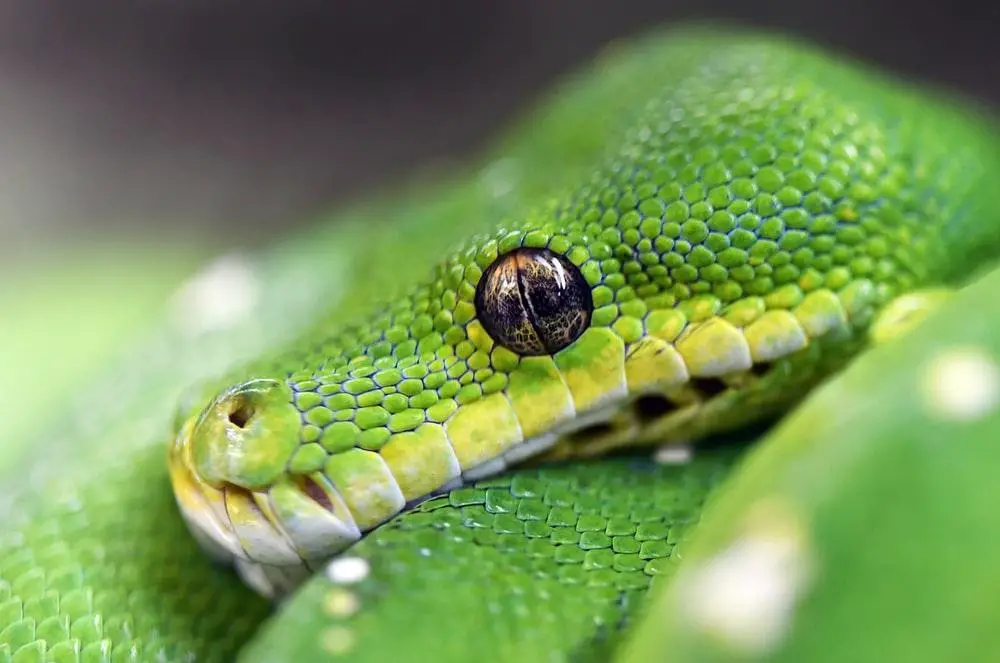
Fun Facts
1. The original taxonomic name of green tree pythons used to be Chondropython Viridis. Because of this, you may often hear green tree pythons still being referred to as “chondros.”
2. When the green tree python was still classified under the genus Chondropython, it used to be the only member of the genus.
3. Due to sharing similar physical attributes, as well as a legendary sitting position, green tree pythons are often confused with emerald tree boas.
4. Green tree pythons make a perfect example of parallel evolution. Even though a green tree python looks and behaves much like the emerald tree boa, which is native to South America, female green tree pythons lay eggs, while emerald green boas give birth to live young.
5. The process that leads to baby green tree pythons changing colors between 6 and 24 months is called ontogenetic color change. By transforming their scales into the classic, vivid green coloration, red baby green tree pythons turn orange before they turn yellow, finally going green, making their transition a bit longer than that of green tree pythons born orange or red.

How to Take Care of a Green Tree Python
1. Green tree pythons do not enjoy being handled before they get to know their owners better as time goes by, and with proper training. Green tree pythons also have longer fangs, as compared with other constrictors. With this in mind, keepers need a suitable enclosure with removable perch.
3. Even when a green tree python has been kept as a pet for a long time, it is still quite possible for the reptile to strike in the case it is handled from the wrong side and/or when startled, so practicing patience and care while handling is a must for starter and experienced caregivers alike.
3. Green tree pythons are known as difficult snakes to care for, although it is more appropriate to state that they are simply not the best choice for beginners. If you are in search of your very first pet snake, you should probably go for other types rather than the green tree python as it requires an in-depth understanding of serpents and some previous experience on that matter.
4. Maintaining temperature and humidity within the recommended rates is also a must in order to take the best care for a green tree python. Too little humidity can easily result in issues for the serpent shedding its skin. Too much humidity can quickly lead to the development of scale rot.
5. All snakes, including green tree pythons, enjoy having somewhere to hide and rest. They need a hiding place to feel safe and comfortable. However, for green tree pythons, it is crucial that owners do not provide too many hiding places, as these fascinating creatures could get completely hidden, often becoming ill and/or aggressive as a result.
6. Green tree python owners should feel free to use protective gloves when handling their pet, although gloves are normally not necessary unless the reptile is feisty.
7.It is best to handle a green tree python during the day when the reptile is less active. In the night, green tree pythons are more active, and hence, they tend to be more aggressive when handled.
8. Do not handle a green tree python pet after handling prey items as your fingers will smell like food, provoking the serpent to strike at you.
9. Green tree pythons are fully capable of learning, so with patience, care, and proper training, they are soon to stop striking their owner, thanks to learning that striking at their keeper doesn’t really help at all.
10. A feeding schedule should be established, and the reptile’s weight is best to be monitored on a regular basis.
FAQ Section
When Will my Green Tree Python Turn Green?
Green tree pythons start to exhibit their attractive, vivid green colors as they mature, typically within 24 months from a hatchling. Apart from the green coloration ranging in shades, it is not uncommon for adult green tree pythons to exhibit blue coloration smattering, too.
Is a Green Tree Python Snake a Good Choice for Beginners?
Green tree pythons tend to be tougher to care for than other snakes one can keep as pets, such as corn snakes, boa constrictors, and ball pythons, among others. A green tree python is not the best choice for beginner keepers. However, with proper research, understanding of the reptile’s characteristics and behavior, as well as through proper training, even the novice can learn how to take good care of a green tree python.
Are Green Tree Pythons Aggressive?
It is totally unfair to state that green tree pythons are aggressive in general. Despite earning a bad reputation over the years, with claims for green tree pythons being much more aggressive than other snakes, this is not 100% true. The attitude of a green tree python is greatly determined by how the reptile has been treated, so aggression is merely a reflection of the keepers/breeders’ attitude rather than the snake’s nature.
Will a Green Tree Python Make a Good Pet?
Green tree pythons can make great pets for some keepers, or they can make bad pets for other keepers. If you are looking for a snake that would be a good companion for sitting and simply chilling with, the green tree python is not the best choice. However, green tree pythons are gorgeous display snakes, and they can teach their caregivers’ plenty of invaluable lessons and virtues.
Are Green Tree Pythons’ Bites Dangerous to Humans?
If one is to get in touch with a quality, captive-bred green tree python in perfect health, this snake carries little to no dangers to humans, except for the painful bite in the case it strikes. However, even if a green tree python is to bite a human being, the reptile cannot cause lethal harm as it does not have any poison or venom.
How Long Will a Green Tree Python Become?
The average length of a green tree python is about 1.6 to 1.8 meters, the equivalent of 5 – 6 feet. Occasionally, some can grow up to 2.2 meters (7 feet).
When Do Green Tree Pythons Shed Skin?
Green tree pythons experience the most shedding when they are still juveniles. Juvenile green tree pythons typically shed every 6 – 8 weeks.
Do Green Tree Pythons Require UVB Lighting?
Green Tree Pythons, do not require UVB lighting in terms of keeping them in perfect health. However, using a UVB bulb can enhance the green tree python’s vivid coloration.
Are Green Tree Pythons Docile Creatures?
If you leave your green tree python alone, it is a perfectly docile creature, so the short answer is YES. Green tree pythons do only strike when startled, provoked, and/or approached without the needed attention and understanding of their nature and needs.
Are Green Tree Pythons Endangered?
Fortunately, green tree pythons are not endangered. However, since they are quite popular among reptile collectors all over the globe, they have been listed as part of the CITES Appendix II, an international treaty that restricts the trade of certain species, including but not limited to green tree pythons.


